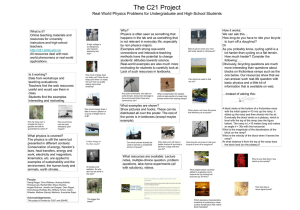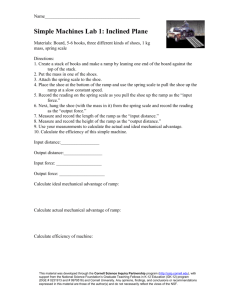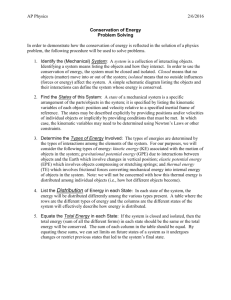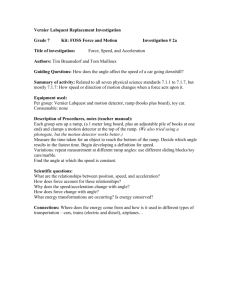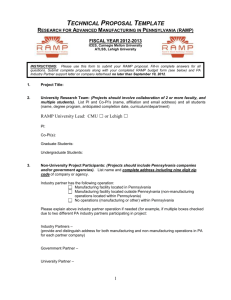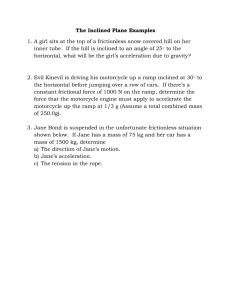Freshman Science Prep Packet
advertisement
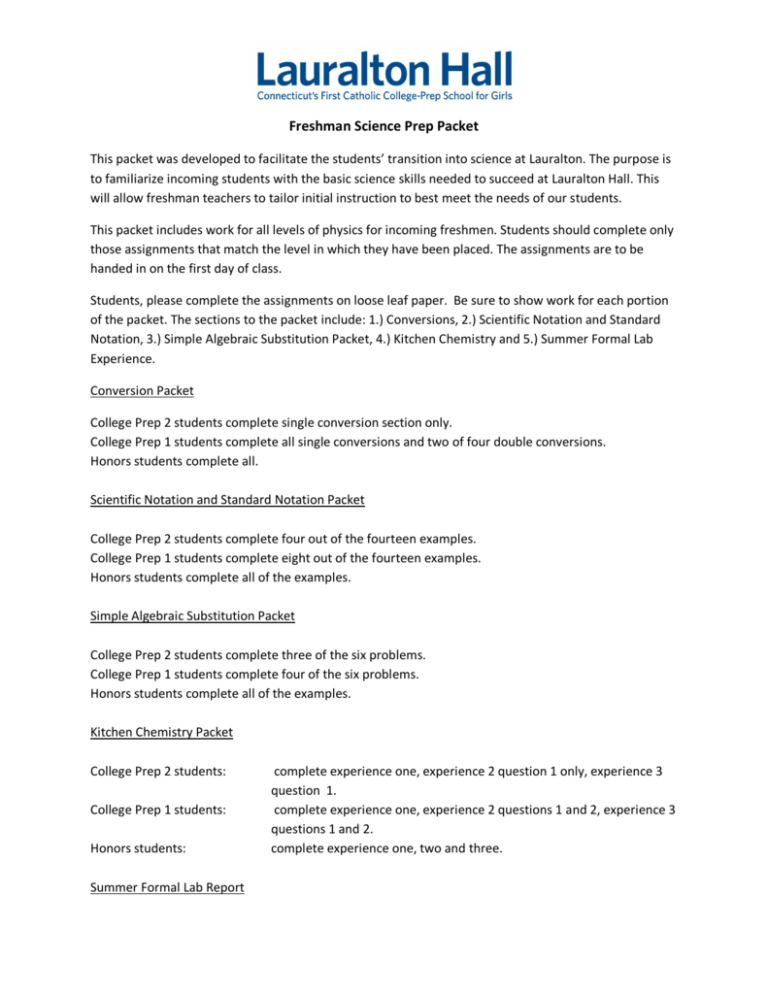
Freshman Science Prep Packet This packet was developed to facilitate the students’ transition into science at Lauralton. The purpose is to familiarize incoming students with the basic science skills needed to succeed at Lauralton Hall. This will allow freshman teachers to tailor initial instruction to best meet the needs of our students. This packet includes work for all levels of physics for incoming freshmen. Students should complete only those assignments that match the level in which they have been placed. The assignments are to be handed in on the first day of class. Students, please complete the assignments on loose leaf paper. Be sure to show work for each portion of the packet. The sections to the packet include: 1.) Conversions, 2.) Scientific Notation and Standard Notation, 3.) Simple Algebraic Substitution Packet, 4.) Kitchen Chemistry and 5.) Summer Formal Lab Experience. Conversion Packet College Prep 2 students complete single conversion section only. College Prep 1 students complete all single conversions and two of four double conversions. Honors students complete all. Scientific Notation and Standard Notation Packet College Prep 2 students complete four out of the fourteen examples. College Prep 1 students complete eight out of the fourteen examples. Honors students complete all of the examples. Simple Algebraic Substitution Packet College Prep 2 students complete three of the six problems. College Prep 1 students complete four of the six problems. Honors students complete all of the examples. Kitchen Chemistry Packet College Prep 2 students: College Prep 1 students: Honors students: Summer Formal Lab Report complete experience one, experience 2 question 1 only, experience 3 question 1. complete experience one, experience 2 questions 1 and 2, experience 3 questions 1 and 2. complete experience one, two and three. Complete the lab assigned for your level. Final Submission (due first day of class) 1. Loose leaf sections 1 – 4. 2. Typed Summer Formal Lab Experience. CONVERSION PACKET CP2 must complete single conversions only. CP1 must complete all single conversions as well as two of the four double conversions. Honors must complete all single and double conversion practice problems. The way we refer to a particular measurement is called a “unit”. For example, we measure money in dollars. “Dollars” is a unit. However, there are other units that you may use to measure money, like quarters, dimes, and nickels. Sometimes, it is necessary to go from one type of unit to another to measure the same quantity. For example, it is helpful when shopping to know that one dollar equals four quarters. When the cashier tells you your purchase is $33.75, you immediately convert in your head the remaining 0.75 dollars into quarters. You know that because 1 dollar equals four quarters and 0.75 is ¾ of a dollar, that means you need to hand the cashier 33 dollars plus 3 quarters. In science, we call this unit conversion. Converting between units uses equivalences, or things that are equal to each other. For example, “1 dollar = 4 quarters” is an equivalence. Equivalences can be shown as a ratio or fraction: 1 dollar 4 quarters (one dollar per 4 quarters) It could also be expressed as 4 quarters (four quarters per one dollar) 1 dollar Equivalences may be given or commonly known, for example: 1 dollar = 4 quarters = 10 dimes = 20 nickels = 100 pennies 1 hour = 60 minutes 1 minute = 60 seconds 1 mile = 1,610 meters Or equivalences may be based on the Metric System. The Metric System is a series of prefixes used to describe quantities in multiples of 10. By using these prefixes, scientists can express very large or very small numbers much more easily. Prefix Kilo (k) Largest Hecto (h) Deka (da) Base units: Meter (m), Liter (L), gram (g), second (s) Meaning 1,000 100 10 1 Example Kg = kilogram = 1,000 grams hL = hectoliter = 100 Liters das = dekasecond = 10 seconds 1 meter, 1 Liter, 1 gram, 1 second Deci (d) Centi (c) Milli (m) Smallest 0.1 or 1/10 0.01 or 1/100 0.001 or 1/1,000 dm = decimeter = 1/10 of a meter cm = centimeter = 1/100 of a meter mm = millimeter = 1/1,000 of a meter Would it make sense to measure the length of a school day in seconds? No. However you could measure the school day in hours and then CONVERT to seconds. The following page shows the steps to do such a conversion. STEPS TO CONVERT BETWEEN UNITS: 1) Start with what you know (what you are given). For example, I KNOW I am in school for 6 and a half hours, or 6.5 hrs. 2) Find out what you want to know (units you are trying to convert to). For example, I WANT TO KNOW how many seconds I spend in school. 3) Write the expression. For example, 6.5 hr = ___ s 4) Multiply by an equivalence in the form of a fraction, or ratio. a) Write the known value (6.5 hr) b) Draw multiplication symbol and fraction line ( 6.5 hr . ________________ ) c) Which unit do you want to get rid of? (hr) d) Which unit do you want to end up with (s) e) In order to cancel out the unit you don’t want, how would you set up your ratio? (hr on the bottom, s on the top: 2.5 hr . __________s ) hr f) You must fill in the ratio numbers so that the equivalence is true. g) 1 hour = 3600 seconds so: 6.5 hr . _3,600 s 1 hr h) Use a calculator to multiply across the top (6.5 X 3,600 s ) and divide by denominator (1). Single Conversion Practice Problems: Below is an example of how to solve a single conversion. a) What do you have and what do you want? 78.2 mL = ___L b) Set up conversion fraction: 78.2 mL . _____________L mL c) Make the equivalence true and calculate: 78.2mL . ____1___L = (78.2 x 1L) = 0.0782 L 1000 mL 1000 For the above problem, I used the Metric System Table to determine that 1 Liter = 1,000 mL. Single Conversion Practice Problems: (answers are in brackets) 1) 1 km = ____ cm [100,000 cm] 2) 4.5 dL = ____ L [0.45 L] 3) 6.78 hL = _____ mL [678,000 mL] Double Conversion Practice Problems: these are solved the same way as single conversions, but you need to have two ratios. Below is an example of how to solve a double conversion. I know I have am traveling at 1 kilometer per hectosecond, but I want to know how fast this is in meters per second: 1 km = _?__m hs s Set up two conversion fractions; one deals with length, the other with time: 1 km . ___hs . _____m hs s km Make the equivalences true (use the Metric System Table) Multiply across the top and divide by the bottom: 1 km . __1__hs hs 100 s (1 x 1 x 1000 m) = 1000 m = 10 m (1 x 100 x 1 s) 100 s s Double (2 step) Conversion practice problems : answers are in brackets 1) . 2) 3) ? = . [0.1 km/hs] ? = = [0.02 ds/mL] ? . __1000_m 1 km [2.625 m/mL] 4) . . = ? [0.2 cm/ms] SCIENTIFIC NOTATION RULES Scientific notation is used to write really large or really small numbers as a type of shorthand using exponents. Proper scientific notation is written as c x 10n c is a decimal number greater than or equal to one and less than 10. n is the number of times you have moved the decimal point. If you move the decimal point to the left, n is positive. If you move it to the right, n is negative. example 1: 3450 = 3.450 x 103 we moved the decimal 3 places to the left, therefore c became 3.450 and n is +3 example 2: 0.000547 = 5.47 x 10-4 we moved the decimal 4 places to the right, therefore c became 5.47 and n is -4 So how do I go from scientific notation to standard form? Move the decimal n times to the right or left depending on whether n is positive or negative. If n is positive, move the decimal to the right – this will make it a bigger number than c. If n is negative, move the decimal to the left – this will make it a smaller number than c. example 1: 2.36 x 105 = 236000 we moved the decimal 5 places to the right because n was +5 example 2: 8.2 x 10-9 = 0.0000000082 we moved the decimal 9 places to the left because n was -9 Scientific Notation vs. Standard Notation Packet CP2 must complete 4 of 14, CP1 must complete 8 of 14, H must complete all. Part I. The following numbers are in standard notation. Write them in in scientific notation. 1. 456.78 = 2. 105693 = 3. 0.0000238096 = 4. 0.010002 = Part II. Calculate the following and report the answer in scientific notation. 5. 2045 / 3.5 = 6. 100004 / 263 = 7. 795 / 3 = 8. 17 / 10006 = 9. 45 x 109 = 10. 3 x 10007 = Part III. The following numbers are in scientific notation. Write them in in standard notation. 11. 2.45 x 104 = 12. 7892 x 1023 = 13. 98.3 x 10-7 = 14. 5.4 x 10-9 = Simple Algebraic Substitution Packet *For the purposes of this practice sheet, unit determination and inclusion will be omitted. This will be addressed within the course content. (CP2) Must complete 3 out of the 6 problems below (CP1) Must complete 4 out of the 6 problems below (H) Must complete 6 out of 6 problems below. I. Linear F = ma (F = force, m = mass, a = acceleration) 1. If a force of 8 is applied to a mass of 2, what would be the acceleration? 2. If a mass of 4.5 accelerates at 7.0, what was the force applied? 3. Find the mass of an object that is accelerated at 9.25 when a force of 28 is applied. II. Fractional (s = d ) t (s = speed, d = distance, t = time) 1. If a car drives a distance of 17.4 in a time period of 60, what is its speed? 2. If a biker travels for a time of 40 at a speed of 84, what is the distance covered? 3. If a runner is traveling at a speed of 5.5, and she travels a distance of 20, what was her time? KITCHEN CHEMISTRY Lab Experience 1: All levels must answer questions 1-2 1. Match the following measurements with the appropriate units: a) mass 1. liters b) time 2. seconds c) distance 3. meters d) volume 4. kilograms 2. Locate a common household item. List the item and state the unit of measurement used. Is it mass, length, or volume? Lab Experience 2: 1. (All Levels) Find the length of your favorite TV show in minutes. 2. (CP1 and H) Convert this to seconds. (1 minute = 60 seconds) 3. (H) Convert this to days. Lab Experience 3: 1. (All Levels) Find the length, width, and height of your kitchen sink in centimeters. 2. (CP1) Find area in cm2 and volume in cm3. You must research the appropriate equations depending on the shape of your sink. 3. (H) Calculate how many bottles of 20 oz soda can be poured into the sink to fill it to the very top with soda. Summer Formal Lab Experience (CP2): This lab must be typed. Introduction: Design an experiment where an object will roll down an inclined plane (ramp) three times. The object and ramp must be the same object and ramp for all three trials. It must be set up so that the object has room to roll off the ramp and continue unobstructed until it stops. You will be varying the steepness (height of release) of the ramp and determining what happens to the distance of the rolling object as the height of release increases. You may not push the rolling object down the ramp. You must merely place it on the ramp and release it. h [ d ] With each trial, make the ramp steeper, which will change your height of release. Height of release and distance must be recorded in meters! If you do not have a meter stick, you can use conversions from inches or feet to meters. You will have to research these conversions. COMPLETE THE FOLLOWING: What is the purpose of this lab (what am I trying to find?): ______________________________ _____________________________________________________________________________ _____________________________________________________________________________ Form a hypothesis (What do you think will happen?)___________________________________ _____________________________________________________________________________ Materials Used: _______________________________________________________________ ____________________________________________________________________________ Procedure (Steps you took to conduct this lab) ________________________________________ _____________________________________________________________________________ _____________________________________________________________________________ ______________________________________________________________________________ INSERT ANY MATHEMATICAL WORK HERE: Data Table #1. Height of release vs. distance off ramp Trial 1 2 3 Height of release (m) Distance rolled (m) Describe in one sentence a pattern that you notice here:________________________________ ____________________________________________________________________________. THE “IV” IS CHANGED BY ME; THE “DV” IS THE RESULTS I SEE. Identify the independent variable (IV): ________________________________________ Identify the dependent variable (DV): _________________________________________ Make a graph illustrating what happens to distance rolled when height of release is changed. Plot the independent variable on the x-axis and the dependent variable on the y-axis. Be sure to include labels and units for axes as well as a graph number and title. Draw a conclusion: a) Was your hypothesis correct? Use data from your data table to discuss this. b) Where have you experienced something similar? Summer Formal Lab Experience (CP1): This lab must be typed. Introduction: Design an experiment where an object will roll down an inclined plane (ramp) three times. The object and ramp must be the same object and ramp for all three trials. It must be set up so that the object has room to roll off the ramp and continue unobstructed until it stops. You will be varying the steepness (height of release) of the ramp and determining what happens to the distance of the rolling object as the height of release increases. You will also be determining the time it takes the ball to travel down the ramp. You may not push the rolling object down the ramp. You must merely place it on the ramp and release it. h [ d ] With each trial, make the ramp steeper, which will change your height of release as well as the time to travel the inclined plane. Height of release and distance must be recorded in meters, time in seconds! If you do not have a meter stick, you can use conversions from inches or feet to meters. You will have to research these conversions. COMPLETE THE FOLLOWING: What is the purpose of this lab (what am I trying to find?): ______________________________ _____________________________________________________________________________ _____________________________________________________________________________ Form a hypothesis (What do you think will happen?)___________________________________ _____________________________________________________________________________ Materials Used: _______________________________________________________________ ____________________________________________________________________________ Procedure (Steps you took to conduct this lab) ________________________________________ _____________________________________________________________________________ _____________________________________________________________________________ ______________________________________________________________________________ INSERT ANY MATHEMATICAL WORK HERE: Data Table #1. Height of release vs. distance off ramp Trial 1 2 3 Height of release (m) Distance rolled (m) Describe in one sentence a pattern that you notice here:________________________________ ____________________________________________________________________________. Identify the independent variable:________________________________________ Identify the dependent variable: _________________________________________ Data Table #2. Height of release vs. time down the inclined plane Trial 1 2 3 Height of release (m) Time (s) Describe in one sentence a pattern that you notice here:________________________________ ____________________________________________________________________________. Identify the independent variable:________________________________________ Identify the dependent variable: _________________________________________ Make 2 graphs illustrating what happens to distance rolled when height of release is changed AND what happens to time down the inclined plane when height of release is changed. Plot the independent variable on the x-axis and the dependent variable on the y-axis. Be sure to include labels and units for axes as well as a graph number and title. Draw a conclusion: a) Was your hypothesis correct? Use data from your data tables to discuss this. b) Where have you experienced something similar? Summer Formal Lab Experience (H): This lab must be typed. Introduction: Design an experiment where an object will roll down an inclined plane (ramp) three times. The object and ramp must be the same object and ramp for all three trials. It must be set up so that the object has room to roll off the ramp and continue unobstructed until it stops. You will be varying the steepness (height of release) of the ramp and determining the average speed of the object as it rolls to a stop. You may not push the rolling object down the ramp. You must merely place it on the ramp and release it. h d With each trial, make the ramp steeper, which will change your height of release as well as the time to travel the inclined plane. Height of release and distance must be recorded in meters, time in seconds! If you do not have a meter stick, you can use conversions from inches or feet to meters. You will have to research these conversions. Formula for speed: s = d t d = length of ramp + distance to stop off ramp t = time from release to stop COMPLETE THE FOLLOWING: What is the purpose of this lab (what am I trying to find?): ______________________________ _____________________________________________________________________________ _____________________________________________________________________________ Form a hypothesis (What do you think will happen?)___________________________________ _____________________________________________________________________________ Materials Used: _______________________________________________________________ ____________________________________________________________________________ Procedure (Steps you took to conduct this lab) ________________________________________ _____________________________________________________________________________ _____________________________________________________________________________ ______________________________________________________________________________ INSERT ANY MATHEMATICAL WORK HERE: Data Table #1. Height of release vs. distance off ramp Trial 1 2 3 Height of release (m) Distance rolled (m) Time (s) Average Speed (m/s) Describe in one sentence a pattern that you notice here:________________________________ ____________________________________________________________________________. Identify the independent variable: ________________________________________ Identify the dependent variable: _________________________________________ Make a graph illustrating what happens to average speed of the object when height of release is changed. Plot the independent variable on the x-axis and the dependent variable on the y-axis. Be sure to include labels and units for axes as well as a graph number and title. Draw a conclusion: a) Was your hypothesis correct? Use data from your data table to discuss this. b) Where have you experienced something similar?

